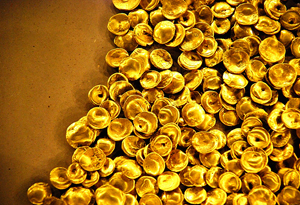Gold Rush

Photo: Bogen Freund
Few materials are as valued as gold—for investment stability, for beautiful jewelry and for manufacturing flexibility. But environmental journalist Simran Sethi says there's an ugly side to our love of gold.
I am Indian, therefore I love gold. Seriously, my people love the stuff, which explains why India is the top gold manufacturer in the world. Attend an Indian wedding, and you'll see a bride with gold dripping from her arms, legs, nose and forehead. Participate in an upscale Diwali New Year's festival, and you'll see sweets like burfi decorated with thin slivers of gold and silver. We can't get enough of gold—and we aren't alone.Gold has been used to symbolize wealth and power since 4000 B.C. It's found in everything from jewelry to injections for rheumatoid arthritis (I used to massage the points on my granny's knees when she got her gold shots) to wiring in electronics like cell phones and laptops. Gold is used not just as currency, but also as financial backing for currency (the "gold standard") and as an investment hedge against inflation (gold tends to hold its value better than other kinds of investments).
In the past few weeks, the price of gold hit an all-time high and is selling for roughly $1,200 per ounce. But the true cost of gold is even higher.
According to Worldwatch Institute, the production of one golden ring creates 20 tons of mine waste, which makes gold the most environmentally destructive metal in existence. Two-thirds of the bling we buy is newly mined and usually sourced through underground or open-pit mining, in which gold is excavated from hard rock.
The processing technique that's been in vogue over the past few decades is called cyanide heap leaching. A cocktail of sodium cyanide percolates through piles of crushed ore, picking up little bits of gold as it passes through. That cyanide-laced waste—known as "tailings"—pollutes water, kills fish and contaminates soil. Tailings include byproducts such as mercury and other heavy metals, which end up in groundwater and cycle back into our food chain. After the gold is separated, it's smelted under intense heat, emitting sulfur dioxide that contributes to smog and acid rain.
The World Gold Council's 2008 estimates show that China, South Africa, the United States and Australia are top sources for mining. Much of this gold is produced on indigenous peoples' lands, leaving communities with the fewest resources and least political clout to contend with the legacy of mining long after the gold is extracted. Close to home, Utah's Bingham Canyon, the world's largest open-pit mine, is visible from outer space. Meanwhile, the arid state of Nevada has suffered radically reduced water tables around some of its open-pit mines.
Maybe we should remember the edict, "All that glitters is not gold." Jewelry is the number one use for gold, so I've raided my mother's jewelry box for old gold (produced pre-cyanide heap leaching) and am committed to steering clear of new gold items. Before you set out on your next shopping expedition, consider vintage shops that stock antique gold or seek out retailers that use recycled gold and support sustainable gold production.
Pretty is as pretty does,
Simran
Simran Sethi is an award-winning journalist and associate professor at the University of Kansas School of Journalism and Mass Communications. For more information on Sethi, visit SimranSethi.com and follow her on Twitter @simransethi.
Keep Reading
Redefining what "green" means in the 21st century
Keep toxic chemicals out of your house
A true eco-villain: Styrofoam



